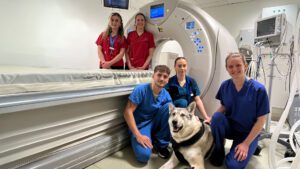Summary
Syringomyelia (SM) in Cavalier King Charles spaniels (CKCSs) is identified commonly on magnetic resonance images and is sometimes associated with clinical signs of pain and cervical hyperaesthesia. However, the mechanism by which SM develops in this breed has not been fully elucidated and the associated effects on spinal cord structure have not been reported previously. The aims of this study were to describe changes found in the spinal cord of CKCSs, to compare findings between symptomatic and asymptomatic dogs and to determine whether syrinx formation was associated with tissue destruction. Anomalies of the central canal were found in all specimens and many dogs had grossly visible fluid-filled cavities within the spinal cord. Prominent microscopical findings were spongy degenerative changes associated with neuronal necrosis and Wallerian degeneration. The ependyma was discontinuous in many specimens, notably in symptomatic individuals, and there was evidence of angiogenesis and fibrous tissue proliferation around blood vessels adjacent to syrinx cavities. Compared with two different samples of the normal dog population, dogs with syrinxes had significantly less grey matter, although this decrease was associated with generalized loss of spinal cord area. Therefore, SM is associated with degenerative changes in the spinal cord and may develop through primary disruption of ependymal integrity followed by vascular hypertrophy and proliferation. Glial and fibrous proliferation appears to be associated with expression of clinical signs.











